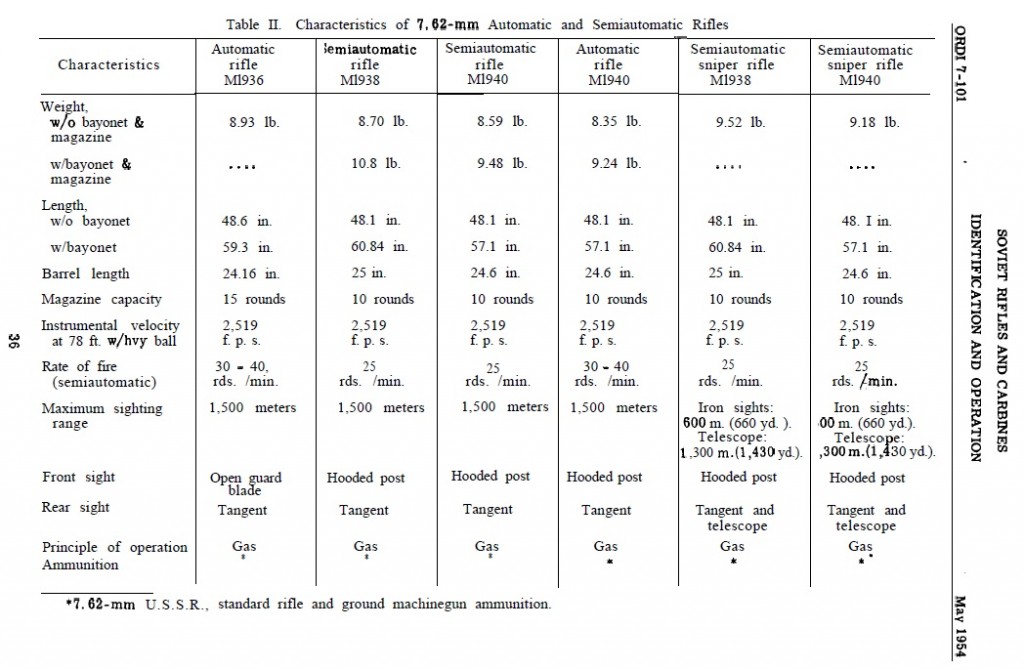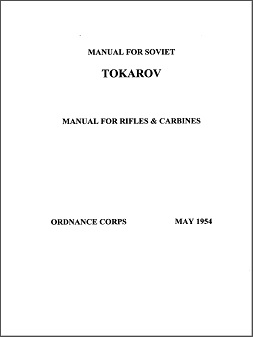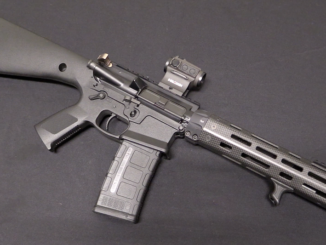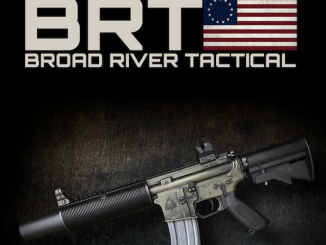One problem I have consistently found with Russian weapons manuals is that they are all written in Russian, which I can’t read. The illustrations are still interesting and useful, but it does make some of the technical details difficult to figure out. However, the US Ordnance Corps happily had a habit of translating manuals for weapons US soldiers are expected to encounter in combat.
In this particular case, the US printed a manual on Soviet rifles and carbines in 1954, which we have acquired a partial scan of. The section we have covers the WWII-era selfloading rifles – the AVS, AVT, and SVT series. In addition to providing maintenance and disassembly instructions, it has a useful section explaining the differences between the various models. Between the updates, sniper, and full auto versions, there six different versions and they can be confusing at first.

The full document is available in PDF format for anyone interested. The text is good, although unfortunately the images have gone through several photocopies too many, and are not very helpful any longer (if we can find a print copy of the manual and make a better digital scan, we will).





Thanks for this, Ian. Very interesting.
Ian .. Great help from you; I have three of these so would sure like the entire document .. how do I go about getting it?
Three SVT-40’s? That’s a pretty decent personal collection, Thomas. Must say I envy you [ in a sincere way 🙂 ]. Perhaps it would not be out of order — as time and resources permit — for you and other Tokarev owners on FW — to put together a document about your personal experiences with the rifle, including your objective professional opinions and recommendations. Just a thought on my part, of course.
I have a single one that I once shot rather a lot. It is an SVT 40 produced in 1941 at Tula. The gun is Finnish capture (SA marked) and presumably came into the USA prior to the GCA 68, as it bears no importer marks. (Most Finnish SVTs were sold to US surplus dealers in the 1950s.
It is a striking-looking firearm and looks positively sinister on the wall of the gun room, with its ventilated wood handguard and stamped upper and lower forward guards. I have a quantity of accessories for it including ammo pouches and spare mags (hard to come by). I also have a bayonet, which does not have the cloth belt hanger part of the sheath. For some reason this is common on these bayonets. The bayonet is a knife type, roughly the size of the 10″ 1942 US Garand bayonet but less sturdy and less well-built.
Indeed, in all things, the gun gives the impression of being less sturdy and less well-built than a Garand or a G43, which are relatively speaking workhorses.
I fired primarily surplus ammunition in it and found it to be unreliable with almost anything. It is particularly unhappy with later 7.62 x 54R steel case, with the extractor merrily tearing off a divot of the case rim and leaving the rest inside. The one design decision that looks brilliant is the inclusion of a cleaning rod.
The chamber is fluted to assist in primary extraction; it’s very hard on brass cases but does not appear to help overmuch. The magazine can be loaded through the stripper clip guide on the bolt carrier.
Disassembly is simple, and it’s not really possible to misassemble. The only tool required for field stripping is a cartridge, although the end of the cleaning rod can be substituted. The firing pin and other small parts are captive. A small hole in the back of the receiver allows cleaning from the breech end — but the rod is too short!
Detail stripping does require tools. Almost every SVT I’ve seen (including mine) is beaten up around the stock screw by Bubba the Gunsmith using pliers, leatherman, etc. (The SVT takedown tool has a spanner-screwdriver that fits this screw; it was once common at gun parts dealers and can also take off a stuck barrel shroud, although that usually comes off by hand with no tool required once the wedge is punched out).
Mine suffered corrosion casualty to the bore while in the safekeeping of a friend. I assume all 7.62 x 54 military ammunition is corrosive and clean accordingly. My friend did not. This made the reliability, already fair to poor, even worse.
One assumes that the professional Soviet military did not have these kinds of reliability issues. (If they did, they were right to shoot Tukhachevskiy).
It hangs on the wall these days, looking mean. It is about the butchest, homeliest, most-likely-to-make-Mike-Bloomberg-wet-himself rifle going. Non-gun-culture people often ask about it: “What’s thaaat!?!” with a shudder. It was once used as part of an elaborate charade that ended the annoying early-morning visits of religious proselytizers to a friend’s apartment in Monterey, California. It also was my first military surplus rifle.
There are a bunch of more recent imports that have been arsenal refinished and had an incorrect and very homely purple blue job done on the bolt and carrier (which should be in the white).
Kevin, I cannot begin to tell you how much I enjoyed your reply about your personal experiences with the SVT-40, and the interesting information you have been kind enough to share. It wasn’t hard to imagine the consternation that must have attended the “Dawn Patrol” of the “religious proselytizers” either :)! As always, many thanks.
Unfortunately, Thomas, I don’t have a copy of the full document. I got this section secondhand…but if anyone reading has the whole thing, I would love to get a copy of it…
Thanks anyway Ian .. you do good! Now I have the title I’ll do some doc searches in DTIC and see what comes up.//
Another interesting document , thanks for sharing Ian
I am assuming that you own a Tokarev Rifle ore know somebody that does , so would it be possible to take some new pictures to replace the ones in the document ?
Always find it strange that such a “flimsy poor design” was manufactured in 1.5 million rifles ( way more than the M1 Garand). Might not have been the best semi auto rifle ever in the world but seemed to work well enough. Have seen many pictures of Germans using 40s as well. I really enjoyed my 40 when I shot it back in the 80s and 90s.
I must agree with you on disassembly of SVT; it’s nearly horrible – extremely awkward. I cannot imagine how ordinary Russian soldiers were able to give it adequate care in front. But, luckily they learned something out of it and Simonov’s carbine was a quantum leap.
Yes, the kinship to the SKS (and to Simonov’s pre-war rifle and AT rifle) is clear. At the very same time Dieudonne Saive was working on the same principle in what would become the SAFN 49 after the war interrupted his work. The FN 49 is much like a non-flimsy Tok, it’s very robust, and of course the same operating principle would go into the very successful FN FAL.
The SKS has a robustness much like the Western weapons, so it’s not that Russians couldn’t do it. References on the Tokarev suggest that the most stressed requirement from Stavka was light weight, and that’s why the AVS and SVT rifles were so light. For such a long rifle, a loaded SVT is light and handy. You’re just not given a feeling of confidence in it as a “bayonet handle.”
Actually nearly four million M1 Garands were made during world war two and close to another 1.5 million in the 1950s not including licensed production in Italy by Beretta and Breda.
Mike … not sure what you mean by “1.5 million Garands. Only two producers of M1 Garands during WW II. Springfield and Winchester. Springfield archive records show from 1932 to end of 1945 SA produced 3,526,922 M1 Rifles. Westinghouse produced a total from 1939 to June 1945 513,880 for a total of 4,040.802 during WW II. In 1952 production resumed by SA, H&R and International Harvester For a total of 4,040.802.
All things considered, including the differences between the two manufacturing techniques, equipment available at the time, material availability, work condition of the workers in each countries production facilities etc; the two type SVT 40’s were a pretty worthy battle weapon.
For born American the Russian language must be un-surmountable challenge and I understand that. So much more I was impressed with one American engineer I had honor to work with who knew it a bit.
By the way, I am not sure if “Tokarov” is entirely wrong, but I am used to see it and hear it as -Tokarev. But that is not of importance; important is that information is available and indeed it is of undisputable value.
A good summary of what matters — right on the mark.
Thank you Earl! From what I understand of what you wrote about your own background I know, that you have appreciation of varied cultures and their deep historical roots. This should apply for all without exception. Learning at least one foreign language expands mental horizon substantially.
I believe this is the manual you are referring to.
Soviet Rifles and Carbines: Identification and Operation
ORDI 7-101
Originally published in May 1954 by the Office of the Chief of Ordnance, U.S. Army, Washington, D.C.
Merriam Press Military Digital Library L29 PDF file download $2.99
Indeed, the copy you have that’s a poor photocopy may have been mine or a photocopy of one. I began selling photocopies of this back in the 1980s and then a PDF file of it in the late 90s. My “original” was an offset reprint done in the 60s or 70s by another outfit, which I no longer recall. My PDF version is a scan of that offset reprint.
http://www.merriam-press.com/sovietriflesandcarbinesordi7-101.aspx
Ray Merriam, Owner, Merriam Press
Just bought a few .. absolutely great. Wonderful information for any military weapons collector. Fill in a lot of info as cross reference other existing documentation. Hope you can add more. Thanks ..
Hot new pictures each day
http://xxxhdnewimage.barjokes.instasexyblog.com/?montana
free porn pictures of sharon mitchell cubby porn charlote grey porn porn idol video italian free shufuni shemale porn video